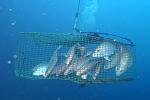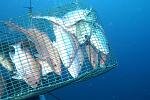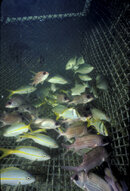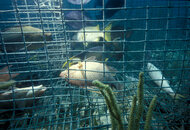Walt Stearns
Contributor
We all need to take a hard look at this.
It appears that commercial fishing lobbyist Bob Spaeth, Southern Offshore Fishing Association is maneuvering the Gulf Council to endorse the return of fish traps in the Gulf of Mexico. This, coming years after the long battle to have them banned from US waters in both the Gulf and South Atlantic EEZs.
Fish traps are without a doubt not only the most controversial gear type ever permitted in the snapper/grouper fishery of the Southeast US, but also the most destructive.
To get an understanding of the damage done by fish traps read this by highly respected and experienced fishery management expert Dr. Russell Nelson - http://www.seawatch.org/bibliography/nelsonpaper.php
The state of Florida banned fish traps in state waters in 1980, yet it took the NMFS over a quarter of a century (not until Feb. 2007) to finally ban the gear in the Gulf of Mexico. Bermuda also recognized fish trapping as an unsustainable method of harvest and banned their use years ago.
Unfortunately, fish trapping is so deeply entrenched in the culture of the Caribbean that many still view it as an acceptable method of harvesting reef fish. In every Island Nation Haiti, Dominican Republic, St. Lucia, St. Maartin, etc., etc., that actively uses fish traps the presence of bottom fish larger than my hand is nearly non existent.
One of the worst assumptions is that the fisherman simply releases the fish they dont want, like angelfish, grunts, etc., or cant legally take like undersize snapper and groupers once a trap is brought to the surface. Not true. Almost nothing survives with a swim bladder (bony fish) after being brought up from depth rapidly. Its common practice among trappers to cut up this by catch, legal or otherwise and use it for bait.
To see what I am talking about watch this video - Explosive Decompression in Fish Traps - Fish Traps: Explosive Decompression on Vimeo or here YouTube - Fish Traps Explosive Decompression Part 1
Now it appears the conservation groups Ocean Conservancy, Oceana and the Environmental Defense Fund (EDF) are willing to consider throwing reef fish under the bus to do what they believe will save sea turtles by sitting down with the Gulf Council and at least two commercial fishing lobby organizations to re-consider fish traps as allowable gear to be included in Amendment 32.
This meeting will be taking place Dec 15th, 2009, 10 AM-4 PM at the Florida Wildlife Research Institute, 100 8th Avenue SE, St., Petersburg, 3rd floor conference room.
Currently this amendment is in the scoping process in order to get some public
feedback before the February Gulf Council meeting in Tampa, Florida.
According to Elizabeth (Libby) Fetherston, Southeast Fish Program Manager for the Ocean Conservancy, We are trying to engage the stakeholder community in a productive dialogue about the issues with this gear type and giving the industry an opportunity to discuss trap evolution and if some of the advancements adequately mitigate the concerns that led to the gear's prohibition in the first place.
Apparently Ocean Conservancy is unclear of its own Mission and even some of the Issues they are fighting against.
The very notion of bringing fish traps back into practice in US waters is highly irresponsible and unconscionable, but some believe that it will cut down on the use of long lines, which do kill sea turtles. However, most commercial fishermen will not be replacing their long line gear for fish traps, they will use both as long as they can get away with it.
The real root of the problem is that the ITQ Individual Transferable Quota mess created by the Gulf Council has basically eliminated all of the smaller more traditional fishing methods, like bandit rigs (a far less destructive form of commercial fishing than nets, long lines and fish traps) and turned the fishery over to those that did the most damage (fish trappers and long liners). To add insult to injury, if the smaller operators want to acquire additional shares they have to buy them from the same individuals who forced them out of business years ago, again, the fish trappers and long liners. The result is the users of the most destructive gear types have been awarded higher ITQ shares and to catch this quota the long liners now want to convert to fish trapping so as to be able to fish more destructively and with less restrictions!
Believe me friends, if this gets passed in the Gulf, it wont stop there. Before we know it fish traps will be back in action all over the US Coast and bottom fish stocks, including both food fish and ornamental species, will once again plunge to disastrously low levels.....like the islands of the Caribbean.
To express your concerns Contact:
Elizabeth Fetherston - Ocean Conservancy
Manager, Fish Conservation, Southeast
E-mail: efetherston@oceanconservancy.org or ph 727-369-6615
Vicki Cornish, Ocean Conservancy
Director, Marine Wildlife Policy
E-mail: vcornish@oceanconservancy.org or ph 202-351-0452
Dave Allison, Oceana
E-mail: dallison@oceana.org or ph 202-467-1945
Pam Baker, Environmental Defense Fund
ph 512-691-3439
It appears that commercial fishing lobbyist Bob Spaeth, Southern Offshore Fishing Association is maneuvering the Gulf Council to endorse the return of fish traps in the Gulf of Mexico. This, coming years after the long battle to have them banned from US waters in both the Gulf and South Atlantic EEZs.
Fish traps are without a doubt not only the most controversial gear type ever permitted in the snapper/grouper fishery of the Southeast US, but also the most destructive.
To get an understanding of the damage done by fish traps read this by highly respected and experienced fishery management expert Dr. Russell Nelson - http://www.seawatch.org/bibliography/nelsonpaper.php
The state of Florida banned fish traps in state waters in 1980, yet it took the NMFS over a quarter of a century (not until Feb. 2007) to finally ban the gear in the Gulf of Mexico. Bermuda also recognized fish trapping as an unsustainable method of harvest and banned their use years ago.
Unfortunately, fish trapping is so deeply entrenched in the culture of the Caribbean that many still view it as an acceptable method of harvesting reef fish. In every Island Nation Haiti, Dominican Republic, St. Lucia, St. Maartin, etc., etc., that actively uses fish traps the presence of bottom fish larger than my hand is nearly non existent.
One of the worst assumptions is that the fisherman simply releases the fish they dont want, like angelfish, grunts, etc., or cant legally take like undersize snapper and groupers once a trap is brought to the surface. Not true. Almost nothing survives with a swim bladder (bony fish) after being brought up from depth rapidly. Its common practice among trappers to cut up this by catch, legal or otherwise and use it for bait.
To see what I am talking about watch this video - Explosive Decompression in Fish Traps - Fish Traps: Explosive Decompression on Vimeo or here YouTube - Fish Traps Explosive Decompression Part 1
Now it appears the conservation groups Ocean Conservancy, Oceana and the Environmental Defense Fund (EDF) are willing to consider throwing reef fish under the bus to do what they believe will save sea turtles by sitting down with the Gulf Council and at least two commercial fishing lobby organizations to re-consider fish traps as allowable gear to be included in Amendment 32.
This meeting will be taking place Dec 15th, 2009, 10 AM-4 PM at the Florida Wildlife Research Institute, 100 8th Avenue SE, St., Petersburg, 3rd floor conference room.
Currently this amendment is in the scoping process in order to get some public
feedback before the February Gulf Council meeting in Tampa, Florida.
According to Elizabeth (Libby) Fetherston, Southeast Fish Program Manager for the Ocean Conservancy, We are trying to engage the stakeholder community in a productive dialogue about the issues with this gear type and giving the industry an opportunity to discuss trap evolution and if some of the advancements adequately mitigate the concerns that led to the gear's prohibition in the first place.
Apparently Ocean Conservancy is unclear of its own Mission and even some of the Issues they are fighting against.
The very notion of bringing fish traps back into practice in US waters is highly irresponsible and unconscionable, but some believe that it will cut down on the use of long lines, which do kill sea turtles. However, most commercial fishermen will not be replacing their long line gear for fish traps, they will use both as long as they can get away with it.
The real root of the problem is that the ITQ Individual Transferable Quota mess created by the Gulf Council has basically eliminated all of the smaller more traditional fishing methods, like bandit rigs (a far less destructive form of commercial fishing than nets, long lines and fish traps) and turned the fishery over to those that did the most damage (fish trappers and long liners). To add insult to injury, if the smaller operators want to acquire additional shares they have to buy them from the same individuals who forced them out of business years ago, again, the fish trappers and long liners. The result is the users of the most destructive gear types have been awarded higher ITQ shares and to catch this quota the long liners now want to convert to fish trapping so as to be able to fish more destructively and with less restrictions!
Believe me friends, if this gets passed in the Gulf, it wont stop there. Before we know it fish traps will be back in action all over the US Coast and bottom fish stocks, including both food fish and ornamental species, will once again plunge to disastrously low levels.....like the islands of the Caribbean.
To express your concerns Contact:
Elizabeth Fetherston - Ocean Conservancy
Manager, Fish Conservation, Southeast
E-mail: efetherston@oceanconservancy.org or ph 727-369-6615
Vicki Cornish, Ocean Conservancy
Director, Marine Wildlife Policy
E-mail: vcornish@oceanconservancy.org or ph 202-351-0452
Dave Allison, Oceana
E-mail: dallison@oceana.org or ph 202-467-1945
Pam Baker, Environmental Defense Fund
ph 512-691-3439








